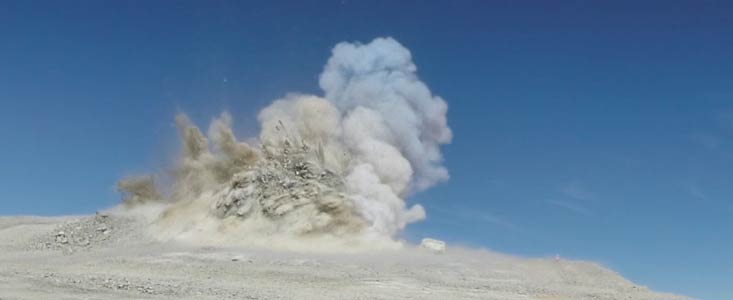Lehdistötiedote
E-ELT -teleskoopin peruskiviseremonia
Seremonia juhlistaa seuraavaa merkittävää askelta matkalla kohti maailman suurinta optista/infrapuna-alueen teleskooppia
19. kesäkuuta 2014
Tänään vietettiin peruskiviseremoniaa osoituksena seuraavasta merkittävästä virstanpylväästä matkalla kohti ESOn E-ELT -teleskooppia (European Extremely Large Telescope). Osa 3000 metriä korkeasta Cerro Armazonesin huipusta räjäytettiin ensimmäisenä askeleena kohti vuorenhuipun tasoittamista maailman suurimman optisen/infrapuna-alueen teleskooppia valmisteltaessa.
Räjäytyspaikalta 20 kilometrin etäisyydellä sijaitsevan Paranalin observatorion peruskiviseremoniaan osallistui arvovaltaisia vieraita sekä Chilestä että ESOn jäsenmaista, sekä paikallisten yhteisöjen edustajia, projektin johtohenkilöitä ja ESOn henkilökuntaa. Tapahtuma videoitiin myös suorana Internetiin ja sen nauhoite on nyt nähtävillä.
Räjäytyksen lähtölaskentakäskyn antoi Chilen valtionomaisuuden varaministeri, Jorge Maldonado.
Peruskiviseremonian aikana chileläinen yhtiö ICAFAL Ingeniería y Construcción S.A. räjäytti osan Cerro Armazonesin huipusta ja irrotti noin 5000 kuutiometriä kiveä. Tämä on vain osa taidokkaasta tasoitusprosessista, joka auttaa muokkaamaan vuorta niin, että sille voidaan rakentaa 39-metrinen teleskooppi valtavine tähtitorneineen. Kaikenkaikkiaan 220 000 kuutiometriä maata pitää siirtää E-ELT -teleskoopin 150 kertaa 300 metriä kokoisen tasanteen tieltä.
Cerro Armazonesin rakennustyöt alkoivat maaliskuussa 2014 ja niiden odotetaan kestävän 16 kuukautta. Työt käsittävät päällystetyn tien perustamisen ja ylläpidon, vuorenhuipun tasanteen valmistamisen sekä huoltokuilun rakentamisen vuoren huipulle [1].
E-ELT -teleskoopin ensivalo on suunniteltu vuodelle 2024 teleskoopin alkaessa selvittää aikamme suurimpia tähtitieteellisiä haasteita. Jättiläisteleskoopin odotetaan mahdollistavan täysin tuntemattomien maailmankaikkeuden alueiden tutkimisen — siitä tulee "maailman suurin tähtitaivasta havainnoiva silmä".
Lisähuomiot
[1] Kaikki paikalle aikanaan pystytettävät rakennukset on määritelty E-ELT -teleskoopin rakennussuunnitelmassa, 264-sivuisessa kaikenkattavassa kirjassa, jossa on yksityiskohdat kaikista projektiin liittyvistä seikoista, sekä yhteenveto. Kesäkuussa 2011 ESOn johtokunta hyväksyi teleskoopin tarkistetun alustavan suunnitelman ja joulukuussa 2012 se hyväksyi täysin E-ELT -teleskoopin rakennusohjelman (ks. myös ann13019, ann13033 ja ann13042).
Lisätietoa
ESO on Euroopan johtava hallitustenvälinen tähtitieteen organisaatio ja maailman tieteellisesti tuotteliain tähtitieteellinen observatorio. ESO:lla on 15 jäsenmaata: Alankomaat, Belgia, Brasilia, Espanja, Iso-Britannia, Italia, Itävalta, Portugali, Ranska, Ruotsi, Saksa, Suomi, Sveitsi, Tanska ja Tšekin tasavalta. ESO toteuttaa kunnianhimoista ohjelmaa, joka keskittyy tehokkaiden maanpäällisten havaintovälineiden suunnitteluun, rakentamiseen ja käyttöön. Välineiden avulla tähtitieteilijät voivat tehdä merkittäviä tieteellisiä löytöjä. ESO:lla on myös johtava asema tähtitieteen tutkimuksen kansainvälisen yhteistyön edistämisessä ja organisoinnissa. ESO:lla on Chilessä kolme ainutlaatuista huippuluokan observatoriota: La Silla, Paranal ja Chajnantor. ESO:lla on Paranalilla Very Large Telescope (VLT), maailman kehittynein näkyvää valoa havainnoiva tähtitieteellinen observatorio, ja kaksi kartoitusteleskooppia. VISTA toimii infrapuna-alueella ja on maailman suurin kartoitusteleskooppi. VLT Survey Telescope on suurin vartavasten taivaan näkyvän valon kartoitukseen suunniteltu teleskooppi. ESO on maailman suurimman tähtitieteellisen projektin, vallankumouksellisen ALMA-teleskoopin eurooppalainen yhteistyökumppani. Parhaillaan ESO suunnittelee 39-metrin kokoista optisen/lähi-infrapuna-alueen European Extremely Large -teleskooppia (E-ELT) josta tulee “maailman suurin tähtitaivasta havainnoiva silmä”.
Linkit
- Katso nauhoitus räjäytyksestä verkossa
- Tietoja E-ELT -teleskoopista
- Taiteilijan näkemyksiä E-ELT -teleskoopista
- E-ELT -teleskoopin rakenne
- E-ELT -teleskoopin suunnitelman hyväksyntä
- Virtuaalikierros Paranalilla ja Armazonesilla (ennen rakennustöiden alkamista)
- Armazonesin tietyön alku
Yhteystiedot
Lars Lindberg Christensen
Head of ESO ePOD
Garching bei München, Germany
Puh.: +49 89 3200 6761
Matkapuhelin: +49 173 3872 621
Sähköposti: lars@eso.org
Pasi Nurmi (Lehdistön yhteyshenkilö Suomi)
ESO Science Outreach Network
ja University of Turku
Turku, Finland
Puh.: +358 29 4504 358
Sähköposti: eson-finland@eso.org
Tiedotteesta
| Tiedote nr.: | eso1419fi |
| Nimi: | Cerro Armazones, Extremely Large Telescope |
| Tyyppi: | Unspecified : Technology : Observatory : Telescope |
| Facility: | Extremely Large Telescope |










